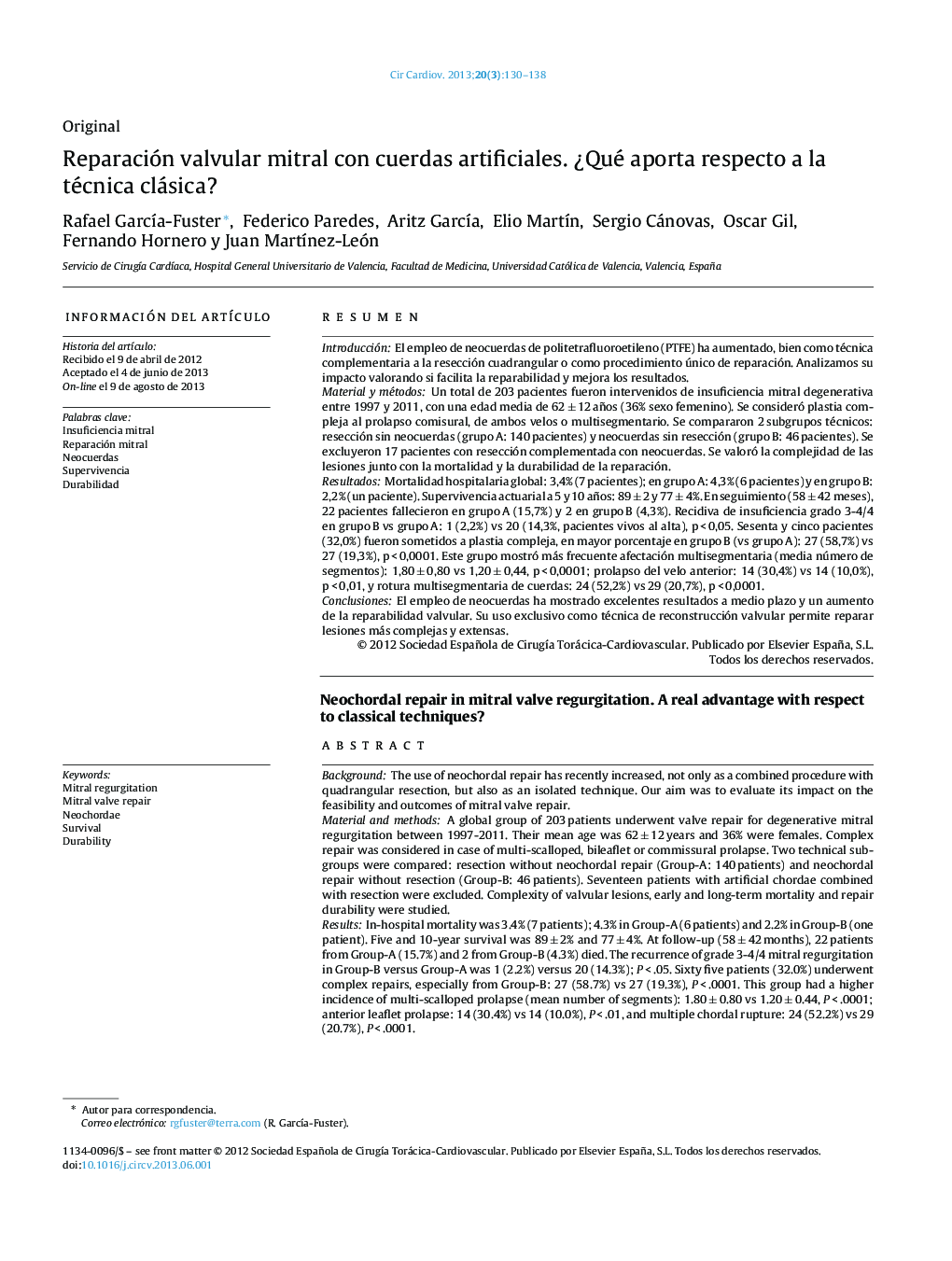| Article ID | Journal | Published Year | Pages | File Type |
|---|---|---|---|---|
| 2908188 | Cirugía Cardiovascular | 2013 | 9 Pages |
ResumenIntroducciónEl empleo de neocuerdas de politetrafluoroetileno (PTFE) ha aumentado, bien como técnica complementaria a la resección cuadrangular o como procedimiento único de reparación. Analizamos su impacto valorando si facilita la reparabilidad y mejora los resultados.Material y métodosUn total de 203 pacientes fueron intervenidos de insuficiencia mitral degenerativa entre 1997 y 2011, con una edad media de 62 ± 12 años (36% sexo femenino). Se consideró plastia compleja al prolapso comisural, de ambos velos o multisegmentario. Se compararon 2 subgrupos técnicos: resección sin neocuerdas (grupo A: 140 pacientes) y neocuerdas sin resección (grupo B: 46 pacientes). Se excluyeron 17 pacientes con resección complementada con neocuerdas. Se valoró la complejidad de las lesiones junto con la mortalidad y la durabilidad de la reparación.ResultadosMortalidad hospitalaria global: 3,4% (7 pacientes); en grupo A: 4,3% (6 pacientes) y en grupo B: 2,2% (un paciente). Supervivencia actuarial a 5 y 10 años: 89 ± 2 y 77 ± 4%. En seguimiento (58 ± 42 meses), 22 pacientes fallecieron en grupo A (15,7%) y 2 en grupo B (4,3%). Recidiva de insuficiencia grado 3-4/4 en grupo B vs grupo A: 1 (2,2%) vs 20 (14,3%, pacientes vivos al alta), p < 0,05. Sesenta y cinco pacientes (32,0%) fueron sometidos a plastia compleja, en mayor porcentaje en grupo B (vs grupo A): 27 (58,7%) vs 27 (19,3%), p < 0,0001. Este grupo mostró más frecuente afectación multisegmentaria (media número de segmentos): 1,80 ± 0,80 vs 1,20 ± 0,44, p < 0,0001; prolapso del velo anterior: 14 (30,4%) vs 14 (10,0%), p < 0,01, y rotura multisegmentaria de cuerdas: 24 (52,2%) vs 29 (20,7%), p < 0,0001.ConclusionesEl empleo de neocuerdas ha mostrado excelentes resultados a medio plazo y un aumento de la reparabilidad valvular. Su uso exclusivo como técnica de reconstrucción valvular permite reparar lesiones más complejas y extensas.
BackgroundThe use of neochordal repair has recently increased, not only as a combined procedure with quadrangular resection, but also as an isolated technique. Our aim was to evaluate its impact on the feasibility and outcomes of mitral valve repair.Material and methodsA global group of 203 patients underwent valve repair for degenerative mitral regurgitation between 1997-2011. Their mean age was 62 ± 12 years and 36% were females. Complex repair was considered in case of multi-scalloped, bileaflet or commissural prolapse. Two technical subgroups were compared: resection without neochordal repair (Group-A: 140 patients) and neochordal repair without resection (Group-B: 46 patients). Seventeen patients with artificial chordae combined with resection were excluded. Complexity of valvular lesions, early and long-term mortality and repair durability were studied.ResultsIn-hospital mortality was 3.4% (7 patients); 4.3% in Group-A (6 patients) and 2.2% in Group-B (one patient). Five and 10-year survival was 89 ± 2% and 77 ± 4%. At follow-up (58 ± 42 months), 22 patients from Group-A (15.7%) and 2 from Group-B (4.3%) died. The recurrence of grade 3-4/4 mitral regurgitation in Group-B versus Group-A was 1 (2.2%) versus 20 (14.3%); P < .05. Sixty five patients (32.0%) underwent complex repairs, especially from Group-B: 27 (58.7%) vs 27 (19.3%), P < .0001. This group had a higher incidence of multi-scalloped prolapse (mean number of segments): 1.80 ± 0.80 vs 1.20 ± 0.44, P < .0001; anterior leaflet prolapse: 14 (30.4%) vs 14 (10.0%), P < .01, and multiple chordal rupture: 24 (52.2%) vs 29 (20.7%), P < .0001.ConclusionsNeochordal repair showed excellent mid-term results with significant increase of repair feasibility. Its use as an isolated procedure has been really effective in patients with more extensive and complex lesions
